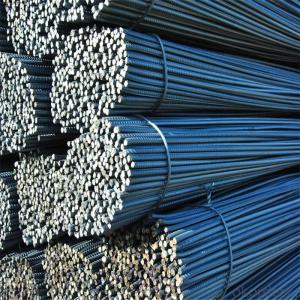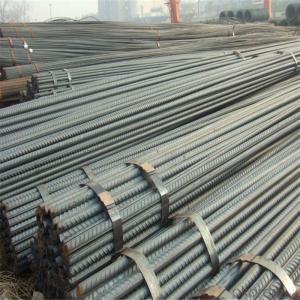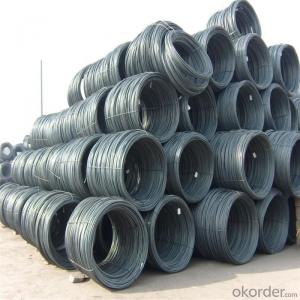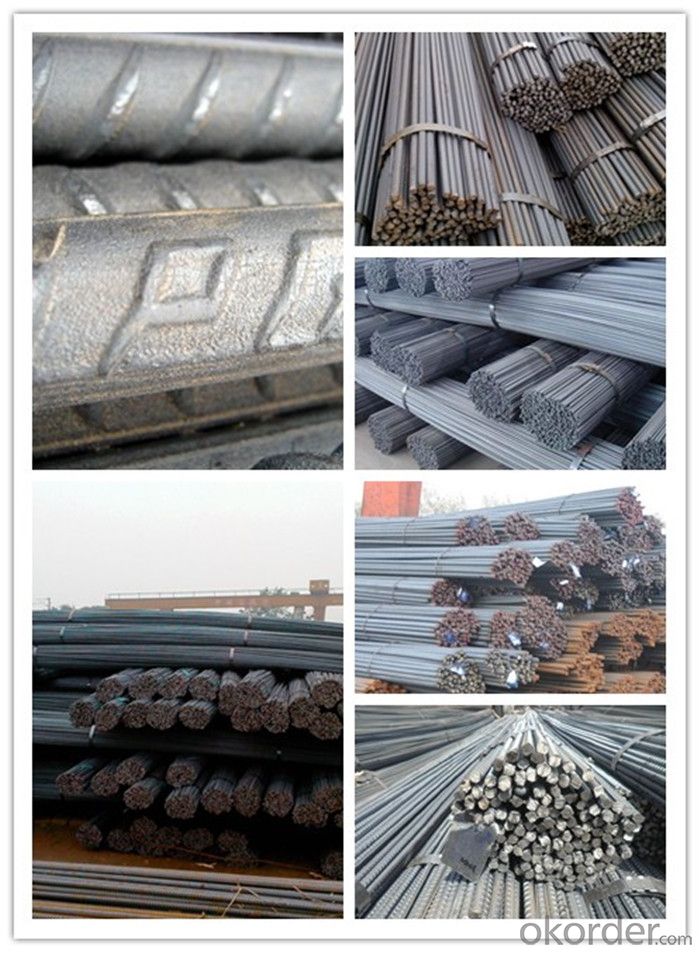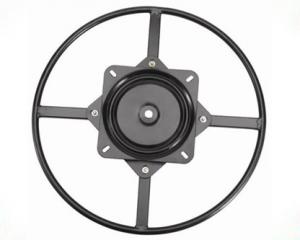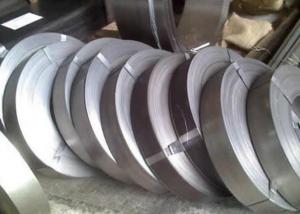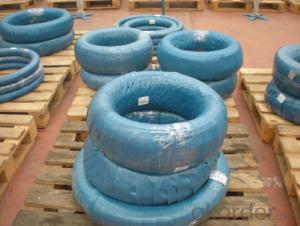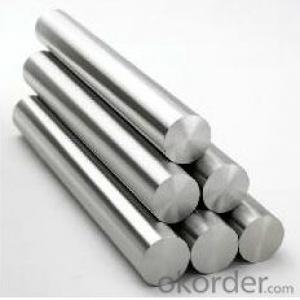Ucraine Turkish Deformed Steel Rebars
- Loading Port:
- Tianjin
- Payment Terms:
- TT OR LC
- Min Order Qty:
- 130 m.t.
- Supply Capability:
- 500000 m.t./month
OKorder Service Pledge
OKorder Financial Service
You Might Also Like
Item specifice
Ucraine Turkish Deformed Steel Rebars
Description of Ucraine Turkish Deformed Steel Rebars
1, Diameter: 5.5mm-10mm Ucraine Turkish Deformed Steel Rebars
10m- 40mm Ucraine Turkish Deformed Steel Rebars
2, Length: 6m, 9m, 12m or customized
3, Standard: GB, ASTM, AISI, SAE, DIN, JIS, EN
OEM technology - send detailed technical parameters for accurate quotation.
2, Produce Process: smelt iron - EAF smelt billet - ESR smelt billet -
hot rolled or forged to get the steel round bar and plate
3, Heat Treatment: annealing, normalizing, tempering, quenching
4, Surface Treatment: Black
5, Quality Assurance: We accept third party inspection for all orders.
You can ask testing organizations such as SGS, BV, etc. to test our products before shipping.
Chemical Composition of Ucraine Turkish Deformed Steel Rebars
Grade | Technical data of the original chemical composition(%) | |||||
Reinforcing steel bar HRB335 | C | Mn | Si | S | P | B |
≤0.25 | ≤1.60 | ≤0.80 | ≤0.045 | ≤0.045 | >0.0008 | |
Physics Capability | ||||||
Yield Strength(N/cm2) | Tensile Strength(N/cm2) | Elongation(%) | ||||
≥ 335 | ≥490 | ≥16 | ||||
Reinforcing steel bar HRB400 | C | Mn | Si | S | P | B |
≤0.25 | ≤0.16 | ≤0.80 | ≤0.045 | ≤0.045 | 0.04-0.12 | |
Physics Capability | ||||||
Yield Strength(N/cm2) | Tensile Strength(N/cm2) | Elongation(%) | ||||
≥ 400 | ≥ 570 | ≥ 14 | ||||
Products Show of Ucraine Turkish Deformed Steel Rebars
Company Information
CNBM International Corporation is the most important trading platform of CNBM group.
Whith its advantages, CNBM International are mainly concentrate on Cement, Glass, Iron and Steel, Ceramics industries and devotes herself for supplying high qulity series of refractories as well as technical consultancies and logistics solutions.


F A Q
1, Your advantages?
professional products inquiry, products knowledge train (for agents), smooth goods delivery, excellent customer solution proposale
2, Test & Certificate?
SGS test is available, customer inspection before shipping is welcome, third party inspection is no problem
3, Factory or Trading Company?
CNBM is a trading company but we have so many protocol factories and CNBM works as a trading department of these factories. Also CNBM is the holding company of many factories.
4, Payment Terms?
30% TT as deposit and 70% before delivery.
Irrevocable L/C at sight.
5, Trading Terms?
EXW, FOB, CIF, FFR, CNF
6, After-sale Service?
CNBM provides the services and support you need for every step of our cooperation. We're the business partner you can trust.
For any problem, please kindly contact us at any your convenient time.
We'll reply you in our first priority within 24 hours.
- Q:How does special steel perform in high-wear applications?
- Special steel is specifically designed to withstand high-wear applications due to its exceptional hardness, toughness, and resistance to deformation. It exhibits superior performance by maintaining its shape, strength, and durability even under extreme conditions such as friction, abrasion, and impact. This makes it an ideal choice for industries where wear resistance is crucial, such as automotive, construction, mining, and manufacturing.
- Q:What are the future trends and innovations expected in special steel production?
- In the future, we can expect several trends and innovations in special steel production. One of the key trends is the development of advanced alloys with improved strength, corrosion resistance, and heat resistance properties. These alloys will be tailored to meet the specific requirements of industries such as automotive, aerospace, and energy. Another trend is the adoption of advanced manufacturing techniques, including additive manufacturing or 3D printing. This technology enables the production of complex geometries and customized components, leading to increased efficiency and reduced material waste. Furthermore, the integration of digital technologies and data analytics will play a significant role in optimizing production processes and improving quality control. Predictive maintenance systems, real-time monitoring, and artificial intelligence-based algorithms will enhance productivity and reduce downtime. Sustainability and environmental concerns will also shape the future of special steel production. There will be a focus on developing greener processes, such as using renewable energy sources and reducing carbon emissions. Additionally, the recycling and reusing of steel will be emphasized to minimize waste and conserve resources. Overall, the future of special steel production will be marked by advanced alloys, additive manufacturing, digitalization, sustainability, and a continued commitment to meeting the evolving needs of various industries.
- Q:What are the different methods for improving the toughness of tool steels used in special steel?
- Tool steels used in special steel applications can be toughened through various methods. The goal is to increase their resistance to fracture and ability to absorb energy without becoming brittle. Some techniques for improving the toughness of tool steels include: 1. Alloying: Adding specific alloying elements like chromium, molybdenum, vanadium, and tungsten significantly enhances the toughness. These elements form carbides within the steel matrix, improving toughness. 2. Heat treatment: Proper heat treatment greatly improves toughness. Quenching and tempering are commonly used processes. Quenching rapidly cools the steel, resulting in a hardened structure. Tempering involves reheating and slow cooling to relieve internal stresses and increase toughness. 3. Controlled cooling rates: Optimizing toughness is possible by controlling the cooling rate during heat treatment. Slow cooling allows for a more uniform microstructure, leading to improved toughness. 4. Grain refinement: Refining the grain size enhances toughness. This can be achieved through hot working, controlled rolling, or adding grain refining elements like titanium or zirconium. 5. Surface treatments: Shot peening or nitriding can improve toughness. Shot peening bombards the steel surface with small metal or ceramic particles, creating compressive residual stresses that enhance toughness. Nitriding diffuses nitrogen into the surface, forming a hard and wear-resistant layer. 6. Cryogenic treatment: Subjecting the tool steel to extremely low temperatures for an extended period refines the microstructure and reduces residual stresses, improving toughness. 7. Powder metallurgy: Techniques like hot isostatic pressing or sintering can produce tool steels with improved toughness. Fine powder, high pressure, and temperature result in a more uniform and fine-grained microstructure, increasing toughness. Ultimately, the specific methods selected and combined depend on the tool steel's requirements and intended application. By carefully considering these techniques, manufacturers can enhance the toughness of tool steels for demanding special steel applications.
- Q:How does special steel perform in high-temperature creep conditions?
- Special steel performs well in high-temperature creep conditions due to its high strength, excellent resistance to deformation, and superior heat resistance properties. It can withstand prolonged exposure to elevated temperatures without significant deformation or structural failure, making it an ideal choice for applications in industries such as aerospace, power generation, and petrochemicals.
- Q:How does hot rolling affect the microstructure of special steel?
- Hot rolling is a metalworking process that involves heating the steel above its recrystallization temperature and then passing it through a series of rollers to reduce its thickness. This process has a significant impact on the microstructure of special steel. During hot rolling, the high temperature causes the grains in the steel to recrystallize, removing any existing defects and creating a more uniform and refined grain structure. This recrystallization process results in smaller and more equiaxed grains, which enhances the mechanical properties of the steel. Additionally, hot rolling promotes the formation of certain microstructural features such as dislocation cells and subgrains. These features help to increase the strength and toughness of the steel, making it suitable for various applications that require high performance and durability. Moreover, hot rolling can also lead to the precipitation of certain alloying elements within the steel. These precipitates can play a crucial role in enhancing specific properties of the steel, such as corrosion resistance or high-temperature strength. Overall, hot rolling has a profound influence on the microstructure of special steel. It refines the grain structure, promotes the formation of beneficial microstructural features, and facilitates the precipitation of alloying elements. These microstructural changes contribute to the improved mechanical properties and performance of the steel, making it a preferred choice in industries such as automotive, aerospace, and construction.
- Q:What are the applications of high-strength low-alloy (HSLA) steel?
- High-strength low-alloy (HSLA) steel finds applications in various industries such as automotive, construction, and manufacturing. It is commonly used in the production of lightweight and durable vehicle components, structural beams, pipelines, and machinery parts. HSLA steel's enhanced strength and toughness make it ideal for applications where weight reduction, increased load-bearing capacity, and resistance to corrosion and impact are crucial.
- Q:How does tool steel maintain its hardness at high temperatures?
- Tool steel maintains its hardness at high temperatures due to its high carbon content and alloying elements. The high carbon content allows for the formation of carbides, which are extremely hard and stable even at elevated temperatures. Additionally, the alloying elements in tool steel, such as chromium, tungsten, and molybdenum, form secondary carbides that further enhance the steel's hardness and heat resistance. These carbides act as strengthening agents, preventing the steel from losing its hardness and maintaining its performance even under high-temperature conditions.
- Q:How are aluminum alloys used in the automotive industry?
- Aluminum alloys are widely used in the automotive industry due to their advantageous properties, such as lightweight, high strength, and corrosion resistance. They are used in various components, including engine blocks, wheels, body panels, and suspension systems, to reduce the weight of vehicles and improve fuel efficiency. Additionally, aluminum alloys provide better heat dissipation, contributing to enhanced performance and longevity of automotive parts.
- Q:What are the effects of different heat treatment processes on special steel?
- Different heat treatment processes have varying effects on special steel. Annealing, for example, helps to soften the steel and increase its ductility, making it easier to shape and work with. Hardening processes, such as quenching and tempering, increase the steel's hardness and strength, making it suitable for applications that require toughness and resistance to wear. Tempering, on the other hand, reduces the hardness of the steel while increasing its toughness. Additionally, heat treatment processes can also influence the steel's internal structure, such as the size and distribution of grains, which in turn affects its mechanical properties. Overall, the choice of heat treatment process can significantly impact the final characteristics of special steel, allowing for customization to meet specific performance requirements.
- Q:How does the demand for special steel vary across different regions?
- The demand for special steel can differ greatly in various regions due to multiple factors. One of the main drivers of demand fluctuation is the level of industrialization in a specific region. Developed regions like North America, Europe, and East Asia, which have strong manufacturing sectors, heavily rely on special steel for various industrial applications, resulting in higher demand. Another factor that affects demand variation is the presence of specific industries or sectors within a region. Regions with significant automotive or aerospace industries require high-performance materials like special steel for the production of vehicles or aircraft, leading to increased demand. Furthermore, the demand for special steel is influenced by the construction industry. Regions experiencing rapid urbanization and infrastructure development, such as Southeast Asia, the Middle East, and parts of Africa, have a higher demand for special steel to construct buildings, bridges, and other infrastructure projects. Moreover, the availability of raw materials and production capabilities within a region can impact the demand for special steel. Regions with abundant access to iron ore, coal, and other essential resources for steel production may experience higher demand as they can efficiently produce special steel. Lastly, economic trends and government policies also play a role in shaping the demand for special steel. Regions with stable economic growth and favorable policies for industries utilizing special steel are likely to have higher demand. Conversely, regions facing economic downturns or restrictive trade policies may witness a decline in demand. In conclusion, various factors, including industrialization levels, specific industries present, construction activities, availability of raw materials, and economic trends, contribute to the variation in demand for special steel across different regions. Understanding these variations is crucial for steel manufacturers and suppliers to effectively target and meet the diverse needs of different regions.
1. Manufacturer Overview |
|
|---|---|
| Location | |
| Year Established | |
| Annual Output Value | |
| Main Markets | |
| Company Certifications | |
2. Manufacturer Certificates |
|
|---|---|
| a) Certification Name | |
| Range | |
| Reference | |
| Validity Period | |
3. Manufacturer Capability |
|
|---|---|
| a)Trade Capacity | |
| Nearest Port | |
| Export Percentage | |
| No.of Employees in Trade Department | |
| Language Spoken: | |
| b)Factory Information | |
| Factory Size: | |
| No. of Production Lines | |
| Contract Manufacturing | |
| Product Price Range | |
Send your message to us
Ucraine Turkish Deformed Steel Rebars
- Loading Port:
- Tianjin
- Payment Terms:
- TT OR LC
- Min Order Qty:
- 130 m.t.
- Supply Capability:
- 500000 m.t./month
OKorder Service Pledge
OKorder Financial Service
Similar products
New products
Hot products
Related keywords


